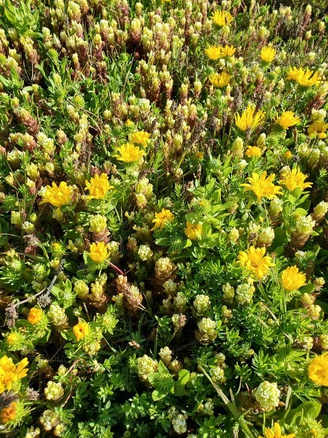Jessica Cejnar / Thursday, July 2, 2020 @ 3:29 p.m. / Community, Parks, Wildlife
(Updated) Eradication Effort Targets False Dandelion Near Lake Tolowa

Marsh bloom, the plant volunteers are hoping to restore. Photo courtesy of Tara Dettmar and Don Hollander.
(Update 7:27 p.m. Friday: The caption in the accompanying photo contained incorrect information. The plant pictured is marsh bloom, the species volunteers are hoping to restore at the Lake Earl Wildlife Area on Sunday.)
Local naturalist Sandra Jerabek and the Tolowa Dunes Stewards normally have European beachgrass in their crosshairs.
But on Sunday, she and her volunteers will set their sights on another invasive that’s beginning to encroach upon a salt water marsh near Lake Tolowa.
Jerabek said she plans to take 10 volunteers to the marsh on the Lake Earl Wildlife Area to remove false dandelion. While thistles, oxeye daisies and other invasive plants are especially prolific this year, fueled by spring rains and a warmer climate, Jerabek said the time to target false dandelion is now.
“This one is still blooming in the marsh and it hasn’t gone to seed yet for the most part,” she said. “Once it goes to seed it’s very hard to get a hold of it. The seeds will blow off in the wind, so you want to get it during that brief period when it’s flowering, and to have it in the marsh, this beautiful salt marsh, is new.”
Jerabek said she and volunteers have been removing the false dandelion at the marsh for about two weeks. She said she feels preventative restoration — eradicating the plant — in the marsh is still possible.
According to Jerabek, these plants can live underwater. Removing them is relatively easy work, though it requires being on one’s knees or bent over to pry the plant up. Getting to the marsh requires a two-mile roundtrip walk sometimes over uneven ground, according to Jerabek.
Though she’s happy to have help, Jerabek said due to COVID-19 safety measures the restoration effort has to be limited to 10 people. It’s first-come, first-serve, she said, asking people to email, call or text her at (707) 954-5253.
The problem with invasive plants in Del Norte County is larger than false dandelion and European beachgrass.
The Del Norte Solid Waste Management Authority, led by volunteer Janet Gilbert, launched a competition to remove tansy ragwort, which is lethal to livestock.
The Tansy Games began Wednesday and will continue through Sept. 7. Individuals and teams are urged to gather as much tansy ragwort as they possibly can and deliver it to the Del Norte Transfer Station. The competition carries a $500 grand prize as well as other incentives, according to a DNSWMA news release.
The DNSWMA processed nearly 10,000 pounds of tansy during last year’s competition.
“We seriously need community engagement and education,” Jerabek said. “It is a goal of the Tolowa Dunes Stewards to do that, but we’re going to need help.”
The California Invasive Plant Council has been able to allocate Legislative dollars to county agricultural departments, Jerabek said, but she’d also like to go after plants that are easily identifiable such as English ivy, Scotch broom and tansy ragwort.
“It’s evident to me that we need help to get the word out, and we don’t have that financial help yet,” she said.
Despite the encroachment of invasive plants this year, Jerabek said it’s been a good year for native bees. The U.S. Fish and Wildlife Service is also considering silvery phacelia for inclusion on the federal Endangered Species list, Jerabek said.
“That plant on our 40 acres is in the numbers of thousands — I’d say it’s between 6,000 and 7,000 (plants),” she said. “We have become the refugia, or stronghold for this plant, which will probably be listed.”
Those who wish to join the effort to remove false dandelion should meet at the locked gate in the large parking lot and trail head at the end of Old Mill Road before 10 a.m. Sunday.
Folks should wear layers, bring water, food and a mask. Participants will be social distancing. People should also bring light-weight gloves and trowels, though sanitized ones will be available if necessary.
CLICK TO MANAGE